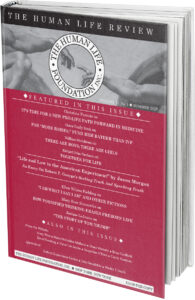What Does ‘Abortion’ Mean? Many People Don’t Know
Most people don’t agree on what the word “abortion” means, a new study finds.
The Guttmacher Institute collected responses from over 2,000 surveys on the subject. Participants were given multiple vignettes and asked if the situation described an abortion.
Even when the scenario stated that the subject “had a surgical abortion,” 25% of respondents said “no,” that was not an abortion.
Guttmacher — a pro-abortion group that was formerly Planned Parenthood’s research arm — also found “ambiguity around … miscarriage, and other reproductive experiences.”
This confusion around the term “abortion” is unsurprising. In medical terminology, miscarriages are known as abortions.
Board-certified obstetrician-gynecologist Dr. Kathleen Raviele explained that “in medical terms, the termination of a pregnancy is called an ‘abortion’ if it occurs at less than 20 weeks of pregnancy.”
Raviele shared how the word “abortion” is usually modified further to indicate how the loss of the child occurred and/or the treatment required.
There is “spontaneous abortion” which is, in layman’s terms, miscarriage; spontaneous abortion indicates that the baby died and mother passed the placenta and body of the child on her own.
Similarly, there is a “missed abortion” which occurs when a baby has already died, but the mother still retains the body of the baby and the placenta, and requires medical help to empty her uterus.
An “incomplete abortion” occurs when the baby has passed, but placental tissue or membranes are retained and the mother requires medical help to empty the uterus.
Finally, there is “induced abortion” or “therapeutic abortion,” which is when a doctor or patient takes an action to terminate the pregnancy. This is the action that policymakers, and the pro-life movement, have in mind when regulating abortion.
It goes without saying that pro-life advocates do not consider miscarriage or related inadvertent medical events to be abortion because the death of the child was not intentional. The same goes for ectopic pregnancy because although treatment for ectopic pregnancy leads to the loss of the embryo, it is not the intent.
Yet it is clear that on the subject of abortion and miscarriage, the pro-life movement and the medical establishment are talking at cross purposes. While the pro-life movement defines “abortion” as the intentional taking of human life in the womb, medical professionals broadly see “abortion” as signifying the end of life in the womb, period.
The same goes for patients. Many passionate testimonies of “abortion” experiences actually describe miscarriage care, or even treatment for ectopic pregnancies.
One woman for the website The Everymom says “abortion saved [her] life after having an ectopic pregnancy.” Yet the procedure she describes is a “salpingectomy,” the standard ectopic pregnancy treatment of pro-life OBGYNs: removal of the fallopian tube to save the mother’s life.
This is a compassionate, pro-life medical intervention for a pregnancy that has implanted outside of the uterus. It is important to note that ectopic pregnancies are not viable and left untreated are also life-threatening to mothers. During the salpingectomy, at no point is the baby in the fallopian tube intentionally killed, but the removal of the fallopian tube causes the death of the child, a death that was already, sadly, inevitable.
Raviele shared that “to the best of [her] knowledge, an ectopic pregnancy has never been called an abortion medically, as the pregnancy cannot pass through the cervix.” Yet this has not stopped pro-choice groups and the media from highlighting ectopic pregnancies as examples of medically necessary abortions.
Whether intentional or unintentional, the frequent miscommunications around abortion, miscarriage care, and ectopic pregnancy have led many medical professionals to seek better phraseology. In its article on the Guttmacher survey, NPR shared how a pro-life medical association is trying to bring clarity by redefining abortion terminology in healthcare.
The American Association of Pro-Life Obstetricians and Gynecologists recently released a glossary for medical professionals defining what constitutes life-affirming medical care around miscarriage, prenatal diagnosis, and infant loss. The glossary recommends swapping the word “abortion” for “intentional feticide” or, if the word “abortion” must be used, prefacing it with “induced” to avoid confusion with miscarriage.
In addition to affecting patient care, NPR notes that the lack of common understanding around “what counts as an abortion has huge implications for abortion restrictions.”
It is clear that the pro-life movement needs to “define our terms” if we hope to help potential converts understand our position on abortion. How can we explain that abortion is wrong if someone thinks that we consider a miscarriage to be abortion?
While it is uncertain if the pro-life movement as a whole will rename “abortion” as “intentional feticide,” in any case, AAPLOG’s glossary is an excellent tool for pro-lifers as they seek to clarify for others what induced abortion is and does. The glossary offers helpful language and explanations that show how women’s health is protected, not threatened, by abortion restrictions and life-affirming medical care — core truths essential in any pro-life message.









